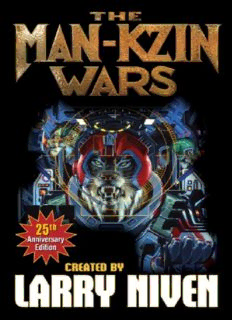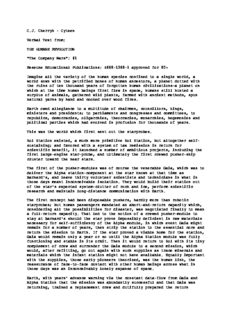
The Man-Kzin Wars - 25th Anniversary Edition PDF
Preview The Man-Kzin Wars - 25th Anniversary Edition
THE MAN-KZIN WARS SERIES Created by Larry Niven The Man-Kzin Wars The Houses of the Kzinti Man-Kzin Wars V Man-Kzin Wars VI Man-Kzin Wars VII Choosing Names: Man-Kzin Wars VIII Man-Kzin Wars IX Man-Kzin Wars X: The Wunder War Man-Kzin Wars XI Man-Kzin Wars XII Man-Kzin Wars XIII Man-Kzin Wars XIV (forthcoming) The Man-Kzin Wars 25th Anniversary Edition The Best of All Possible Wars Destiny's Forge by Paul Chafe Also by Larry Niven Fallen Angels (with Jerry Pournelle & Michael Flynn) THE MAN-KZIN WARS 25th ANNIVERSARY EDITION This is a work of fiction. All the characters and events portrayed in this book are fictional, and any resemblance to real people or incidents is purely coincidental. Copyright © 2013 by Larry Niven All rights reserved, including the right to reproduce this book or portions thereof in any form. A Baen Books Original Baen Publishing Enterprises P.O. Box 1403 Riverdale, NY 10471 www.baen.com ISBN: 978-1-4516-3900-1 Cover art by Stephen Hickman First Baen printing, June 2013 Distributed by Simon & Schuster 1230 Avenue of the Americas New York, NY 10020 Library of Congress Cataloging-in-Publication Data Niven, Larry. The Man-Kzin Wars 25th anniversary edition / created by Larry Niven ; with Poul Anderson and Dean Ing. -- 25th anniversary edition. pages cm Includes bibliographical references and index. ISBN 978-1-4516-3900-1 (trade pb : alk. paper) I. Anderson, Poul, 1926-2001. II. Ing, Dean. III. Title. PS3564.I9M36 2013 813'.54--dc23 2013005968 Printed in the United States of America 10 9 8 7 6 5 4 3 2 1 INTRODUCTION BY LARRY NIVEN MEMOIR From June 1988 to January 2013 When I first said, “No! Known Space is mine,” I was craning around to talk to Jim Baen in the back seat of our car. Marilyn was driving. Jim and I had already done a similar thing for Ace Books, opening up the Magic Goes Away universe to other writers. Now he was pressuring me to open the Known Space worlds. I thought it over, then added, “We can open the Man-Kzin Wars. I don’t do war stories.” I didn’t have a plan then, exactly, but I had hopes. First: I had to hope that other writers would find it intriguing or even lucrative to work in my Known Space universe. To sweeten the deal, I offered to pay the writers all of the advance money and wait until the advance was paid out. Then I’d start earning my cut. Second: I hoped they’d do well by my fictional universe. They did. Mostly they came through spectacularly. It bothered me when I had to reject a story or two, one for violating basic assumptions, one for being dull. I shouldn’t have worried. Jim got other writers to collaborate on turning the duds into something worthwhile. Third: I’d said everything I knew to say about that period in the Known Space universe. I hoped others’ work in the field would re-inspire me. Over these past twenty-five years I’ve added stories to the Man-Kzin Wars aspect of the Known Space universe. I haven’t had a story in every volume, but there have been several. For a while it seemed I was the only one who could write anything short in this universe. It’s been a kind of slow, long range conversation with a gathering horde of other writers. Poul Anderson’s story in this first volume, “Iron”, gives a wonderful overview of Tiamat, the terraformed asteroid in Alpha Centauri’s Serpent Swarm. In fact “Iron” is a wonderful overview of Known Space, with characters from all over that universe. Other writers have found Tiamat and Wunderland to be wonderful settings for their stories. Dean Ing’s “Cathouse” introduced archaic, sapient Kzinti females. Other writers have taken up that thread, which I had somewhat neglected. Donald Kingsbury invented the Jotoki slaves, and several of us have added to their history. It wasn’t my idea to write that the Kzinti stole their ship technology from the Jotoki. Several authors have written of the Kzinti telepaths, which I had neglected. I added Shasht (or Burrowing Murder, or Fafnir) to the canon, a human-acquired world where Kzinti stayed behind to become the fishing industry and the police. I haven’t had to interfere very often. Jean Lamb’s “Galley Slave” went hand to hand with a Kzin; I made her give her a better weapon. Hal Colebatch wrote many stories in the series, including one whole volume. In his second story he made a mistake I’ve made too: he started with an ending and stuck to it after the story had veered. I told him to throw away the last half, and then I outlined a different finish. He could have told me to jump off a cliff. But he wrote it—and wrapped up the tale of the Angel’s Pencil (in “the Warriors”) and left me a slot for Sheathclaws, a world of Kzinti and human telepaths cut off from human space by an arm of the Patriarchy. Matthew Joseph Harrington writes of a human woman turned protector, Peace, whose brilliant banditry has seriously affected Man-Kzin history. Peace’s manipulations seem to have created the Kdaptist Heresy (first seen during Ringworld). So here’s the first volume of the Man-Kzin War series, which currently number thirteen volumes. I hope you’ll enjoy the stories and go on to read many more. INTRODUCTION BY STEPHEN HICKMAN The strongest impression that comes to mind on this 25th anniversary of the first Man-Kzin Wars book is “Holy (beep!), it can’t be twenty-five years, can it!?” We’re only up to volume XIV, after all, hmmm . . . Consequently, my thoughts on the origins of the first covers are a bit hazy (a good thing, as this will make these reminiscences mercifully brief), but such as they are, these are my impressions— I remember thinking, when Mr. Jim Baen was telling me that this was going to be a series (we spoke on the phone in those days) that I would do better not to read the stories, but to go with whatever I could conjure up in my imagination— I had done covers for several series before this, and some of the weakest of my efforts came from being constrained to keep too closely to the subject material. Also, I knew that Jim had no objection whatsoever to ‘illustrating the metaphor’, quite the contrary, in fact. Come to think of it, I may have been the one to have first mentioned that phrase to Jim. So I made up a scene with a Kzin crew in the control room of a spacecraft, and for good measure designed a title logo and border treatment. This latter was to try and prevent the drastic cropping that tends to occur with Baen covers (ahem)—and besides that, it established a unique and distinctive look for the series. This evidently was successful as I got a call from Jim after the initial presentation at the sales meeting, where the cover apparently received a strongly positive reaction from the buyers. Getting positive feedback from a publisher is unheard-of: in my entire previous career I had received only one such call (also from Jim, in fact) about a cover, to put this in perspective. So I was a bit surprised, but really jazzed about the whole series project. I finished up that first cover very carefully—I had sent in a slide of the mostly-finished cover for the sales meeting, where the pilot looked like a white tiger. I was working in acrylic at the time for SF subjects, and it’s very easy to make drastic mistakes with an acrylic painting. Easy for me to makes mistakes with acrylic, I mean to say. For the second cover, I made up something I thought might out-do the first one, and so on for the third . . . Out of curiosity, I read one of the stories in the second volume, and was startled to recognize in it the scene I had done for the first cover—wow, I was ahead of deadline by a whole book! Fast forward to cover VIII, and Jim asks me to please not paint in the title and border any more, as this is giving him headaches trying to fit in the names of the authors. This is a relief to me as this adds considerably to the workload, and incidentally reduces the chances of selling the painting to a collector effectively to zero. Also, I had become fed up once and for all with acrylics as a viable medium (‘liquid linoleum’, as an artist friend of mine refers to it), and so cover VIII was the first I did in oil color. Cover VIII was also the last I did as one of my own ideas— when M-K IX came along I was asked if I would please start reading the stories, and select a scene that actually had something to do with the writing in the book. I found a great scene from a story by Hal Colebatch titled “His Sergeant’s Honor,” and painted that for the cover. I liked the way it turned out, and was relieved, as I discovered, not to have the complete responsibility for the cover image on my own shoulders. And, much to my enjoyment, I have been conscientiously reading the stories ever since—of all the anthologies I have ever discovered in fifty years of reading SF, the Man-Kzin Wars series is easily the most consistently brilliant and well- written. As such, it has been the most challenging series of covers I have ever tackled—certainly the most rewarding in terms of having covers I can be happy with. The stories in M-K XIV are great, by the way—definitely check it out!
The list of books you might like

Mind Management, Not Time Management

Corrupt (Devil's Night #1)

A Thousand Boy Kisses

Atomic Habits James Clear

The Fighting Tomahawk An Illustrated Guide to Using the Tomahawk and Long Knife as Weapons

NASA Technical Reports Server (NTRS) 20060047794: An Exercise in Technology Prioritization in a Competitive Environment

El secreto sumergido

By Invitation Only: Exclusively Yours Private Party Secret Encounter

BY Henry F. Allen, MD

Gazette of India, 2006, No. 42

Receiving Love: Transform Your Relationship by Letting Yourself Be Loved

süleyman gündüz

State of the Judiciary Address 2006

Juvenile Information Governance Commission Report Submitted to the Missouri General Assembly 2005

ERIC EJ744021: Investigating Functions Using Real-World Data

ERIC ED362564: Program Assessment: A Six-Step Process to Curriculum Improvement.

Odisha Gazette, 2006-01-07, No. 53

The Geographical Journal 1993: Vol 159 Table of Contents

C. J. Cherryh - Union Alliance - Cyteen

Black Alibi

Süt Sektör Raporu (Van Süt Eylem Planı)



